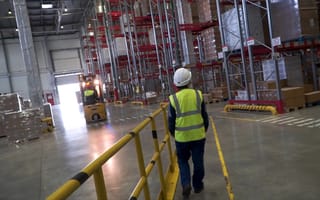
Safety in Amazon warehouses has been the subject of media scrutiny in recent years, particularly for interactions between humans and robots. TechCrunch reports that the online retail giant has been introducing a new worker safety wearable to 25+ sites to prevent accidents involving robotic systems in their warehouses.[1]
The outlet describes the Robotic Tech Vest, which was designed by the Amazon Robotics team, as “really more like a pair of suspenders attached to an electronic utility belt.” Amazon workers entering the vicinity of robots have the added protection of the vest’s built-in sensors, which signals the need to slow down to Amazon’s robotic systems.
“All of our robotic systems employ multiple safety systems ranging from training materials, to physical barriers to entry, to process controls, to on-board,” Amazon Robotics VP Brad Porter told TechCrunch.
“In the past, associates would mark out the grid of cells where they would be working in order to enable the robotic traffic planner to smartly route around that region. What the vest allows the robots to do is detect the human from farther away and smartly update its travel plan to steer clear without the need for the associate to explicitly mark out those zones.”
“In the past, associates would mark out the grid of cells where they would be working in order to enable the robotic traffic planner to smartly route around that region. What the vest allows the robots to do is detect the human from farther away and smartly update its travel plan to steer clear without the need for the associate to explicitly mark out those zones.”[2]
Citing “more than one million unique activations” since the systems have been deployed, Porter touts tests to-date as a “huge success.”
The emergence of robotics in the workplace has brought on a new frontier of workplace safety. TechCrunch published a quote from OSHA stating, “Studies indicate that many robot accidents occur during non-routine operating conditions, such as programming, maintenance, testing, setup, or adjustment. During many of these operations the worker may temporarily be within the robot’s working envelope where unintended operations could result in injuries.”
Porter notes that tests with the vest have a “huge success,” with “more than one million unique activations” having been recorded with the systems it’s deployed thus far.



